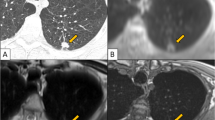Abstract
The purpose of this study was to evaluate low-field MR imaging of the lung parenchyma in comparison with postero-anterior (PA) and lateral chest radiographs (CR). One hundred one prospectively randomized patients who had received routine CR were additionally examined with magnetic resonance imaging (MRI) at 0.2 T. Utilized sequences were: constructive interference in steady state (CISS), true fast imaging in steady state precession (True-FISP) and T1-weighted spin-echo (T1SE). Consensus reading of two observers was performed for CR. Three other observers analyzed hardcopies of the MRI examinations for each sequence independently. The individual results for the comparisons between the sequences and CR were calculated using kappa coefficients with their corresponding confidence intervals. Additionally, an interobserver analysis was performed.The proportions of agreement for the three sequences compared with CR were high, with 0.93 for CISS, 0.89 for True-FISP and 0.91 for T1SE. The kappa coefficients and the corresponding confidence intervals were 0.81 [0.68; 0.95] for CISS, 0.72 [0.57; 0.88] for True-FISP and 0.78 [0.65; 0.92] for T1SE. Concerning CISS, differences between MRI and CR were mainly related to advantages resulting from cross-sectional imaging. The smallest 95% lower confidence bound of the three kappa measures for comparing the MR readers with each other was 0.97, indicating a high interobserver agreement. Low-field MRI of the lung parenchyma using the CISS sequence is well comparable with chest radiography and demonstrates slight advantages resulting from the cross-sectional imaging technique.

Similar content being viewed by others
References
Higgins CB, Byrd BF III, Farmer DW, Osaki L, Silverman NH, Cheitlin MD (1984) Magnetic resonance imaging in patients with congenital heart disease. Circulation 70:851–860
Cohen AM (1984) Magnetic resonance imaging of the thorax. Radiol Clin North Am 22:829–846
Bergin CJ, Pauly JM, Macovski A (1991) Lung parenchyma: projection reconstruction MR imaging. Radiology 179:777–781
Alsop DC, Hatabu H, Bonnet M, Listerud J, Gefter W (1995) Multi-slice, breathhold imaging of the lung with submillisecond echo times. Magn Reson Med 33:678–682
Schmidt MA, Yang GZ, Gatehouse PD, Firmin DN (1998) FID-based lung MRI at 0.5 T: theoretical considerations and practical implications. Magn Reson Med 39:666–672
Deimling M (2000) True FISP Imaging of lung parenchyma at 0.2 Tesla. Proc Int Soc Mag Reson Med 8:2202
Rupprecht T, Bowing B, Kuth R, Deimling M, Rascher W, Wagner M (2002) Steady-state free precession projection MRI as a potential alternative to the conventional chest X-ray in pediatric patients with suspected pneumonia. Eur Radiol 12:2752–2756
Abolmaali ND, Schmidt H, Anjorin A, Posselt H-G, Vogl TJ (2002) Chrispin-Norman-Score and Bhalla-Score of patients with cystic fibrosis: comparative study of chest radiographs and MR-imaging. Eur Radiol 12:227
Heussel CP, Sandner A, Voigtlander T, Heike M, Deimling M, Kuth R, Rupprecht T, Schreiber WG, Kauczor HU (2002) [Prospective feasibility study of chest X-ray vs thoracic MRI in breath-hold technique at an open low-field scanner]. Rofo Fortschr Geb Rontgenstr Neuen Bildgeb Verfahr 174:854–861
Vlasbloem H, Kool LJ (1988) AMBER: a scanning multiple-beam equalization system for chest radiography. Radiology 169:29–34
Nitz W (1997) Bildgebende Sequenzen in der Kernspintomographie und ihre klinische Anwendung. Electromedica 65:8–14
Abolmaali ND, Schmitt J, Krauss S, Deimling M, Jacobi V, Vogl TJ (2001) Fast low-field MR-imaging of lung parenchyma in 58 patients: results of an interobserver analysis. Radiology 213:630
Abolmaali ND, Hietschold V, Appold S, Ebert W, Vogl TJ (2002) Gadomer-17-enhanced 3D navigator-echo MR angiography of the pulmonary arteries in pigs. Eur Radiol 12:692–697
Hauschke D, Schall R, Luus HG (2000) Statistical significance, 1st edn. pp 493–507
Biederer J, Both M, Graessner J, Liess C, Jakob P, Reuter M, Heller M (2003) Lung morphology: fast MR imaging assessment with a volumetric interpolated breath-hold technique: initial experience with patients. Radiology 226:242–249
Kauczor HU, Hofmann D, Kreitner KF, Nilgens H, Surkau R, Heil W, Potthast A, Knopp MV, Otten EW, Thelen M (1996) Normal and abnormal pulmonary ventilation: visualization at hyperpolarized He-3 MR imaging. Radiology 201:564–568
de Lange EE, Mugler JP, III, Brookeman JR, Knight-Scott J, Truwit JD, Teates CD, Daniel TM, Bogorad PL, Cates GD (1999) Lung air spaces: MR imaging evaluation with hyperpolarized 3He gas. Radiology 210:851–857
Moller HE, Chen XJ, Saam B, Hagspiel KD, Johnson GA, Altes TA, de Lange EE, Kauczor HU (2002) MRI of the lungs using hyperpolarized noble gases. Magn Reson Med 47:1029–1051
Keilholz SD, Mai VM, Berr SS, Fujiwara N, Hagspiel KD (2002) Comparison of first-pass Gd-DOTA and FAIRER MR perfusion imaging in a rabbit model of pulmonary embolism. J Magn Reson Imaging 16:168–171
Sommer T, Lauck G, Schimpf R, von Smekal A, Wolke S, Block W, Gieseke J, Schneider C, Funke HD, Schild H (1998) [MRI in patients with cardiac pacemakers: in vitro and in vivo evaluation at 0.5 T]. Rofo Fortschr Geb Rontgenstr Neuen Bildgeb Verfahr 168:36–43
Wagner M, Bowing B, Kuth R, Deimling M, Rascher W, Rupprecht T (2001) Low field thoracic MRI—a fast and radiation free routine imaging modality in children. Magn Reson Imaging 19:975–983
Horinouchi H, Maenaka Y, Sato M, Yuasa Y (1994) [Follow-up study of MRI imaging in a case of traumatic pulmonary hematoma]. Kyobu Geka 47:772–775
Schafer JF, Vollmar J, Schick F, Seemann MD, Mehnert F, Vonthein R, Aebert H, Claussen CD (2002) [Imaging diagnosis of solitary pulmonary nodules on an open low-field MRI system—comparison of two MR sequences with spiral CT]. Rofo Fortschr Geb Rontgenstr Neuen Bildgeb Verfahr 174:1107–1114
Acknowledgements
The authors thank Frank Krummenauer, PhD, Coordination Center for Clinical Trials, University Hospital of Mainz, Germany, for his contribution to the statistical assessment.
Author information
Authors and Affiliations
Corresponding author
Rights and permissions
About this article
Cite this article
Abolmaali, N.D., Schmitt, J., Krauss, S. et al. MR imaging of lung parenchyma at 0.2 T: evaluation of imaging techniques, comparative study with chest radiography and interobserver analysis. Eur Radiol 14, 703–708 (2004). https://doi.org/10.1007/s00330-003-2215-y
Received:
Revised:
Accepted:
Published:
Issue Date:
DOI: https://doi.org/10.1007/s00330-003-2215-y




